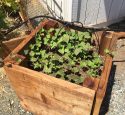Even before the written word, humans saved seeds from their most productive plants. The process was then repeated again and again. With time, those crops became adapted to local conditions, more disease resistant and more productive.
Now, with the limited varieties marketed by large seed companies and mono-cropping (the growing of a single crop over hundreds, even thousands of acres) we are losing this genetic adaptability and resilience.
Biodiversity is indicated by the numbers of different plants and animals in an environment. Over the last one hundred years, the rate of loss of both plant and animal species has accelerated by many folds.
More than 90 percent of our fruit and vegetable varieties may have been lost since 1900. Many also fear that since genetically modified crops (GMOs) promote large scale monocultures, they too contribute to the decline in biodiversity and increase long-term vulnerability of crops and wildlife to climate change, pests and diseases.
Examples of monoculture calamities include the Irish potato famine, American elm die-off in the eastern United States, and even the great American dustbowl which resulted in part from degraded soil.
Biodiversity both below and above the ground blunts effects of disease, invasive insects and climatic change. More microbial diversity below ground means fewer pathogens in the soil with healthier, stronger plants above ground.
When there are many plant species there are many animal species, and vice versa. California boasts nearly 2000 species of native bees that pollinate certain crops (Bumblebees, for example, are excellent blueberry pollinators.) and wildflowers. Colorado scientists found that removing a single native bumblebee species cut wild larkspur pollination and resulting seed production by one-third. The decline of native milkweed plants, the only food of monarch butterfly caterpillars, has contributed to the decline of monarch butterflies.
Pollinator and other insect diversity can be increased by eliminating or carefully targeting pesticides. The so-called “good” bugs then compete and help overcome the “bad” bugs, all the while supporting a myriad of other animal life from frogs to owls to bears.
Human population growth, sprawl and invasive species are seemingly everywhere. Today there are virtually no ecosystems unimpacted by humans, while both plant and animal diversity is declining at an ever accelerating pace. Fifty-percent of the world’s plants, along with the animals that depend on them, are predicted to be condemned to extinction before the end of this century.
Humans are fundamentally responsible for influencing biodiversity’s decline. Humans are also capable of fostering biodiversity. We can reduce/eliminate toxic pesticides in our homes and gardens and grow and purchase organically grown produce. We can provide supportive habitat for pollinators and other insects. We can save seeds, restore our soil, rotate crops, grow heirlooms, and plant fewer exotics and more natives.
The University of California notes that oak woodlands are “the most biologically diverse broad habitat in the state.” Millions of invertebrates (creatures without backbones, largely insects) and over 300 vertebrate species use oak woodlands including 80 mammal species and 170 different kinds of birds. Scores of these creatures are completely dependent on woodlands for food and cover. The oaks in turn rely on rodents and birds to spread their acorns.
Only by working together can we safeguard existing habitats including our native oaks, retain their beauty, and preserve their irreplaceable contribution to biodiversity and ultimately to our wellbeing.
Vera Strader is a University of California Cooperative Extension Master Gardener of Tuolumne County who derives great pleasure from the wildlife that lives in and around her Sonora garden.
UCCE Master Gardeners of Tuolumne and Calaveras Counties can answer home gardening questions. Call 209-533-5912 or go to: http://ucanr.edu/survey/survey.cfm?surveynumber=7269 to fill out our easy-to-use problem questionnaire. Check out our website at: http://cecentralsierra.ucanr.edu/Master_Gardeners/ You can also find us on Facebook.


